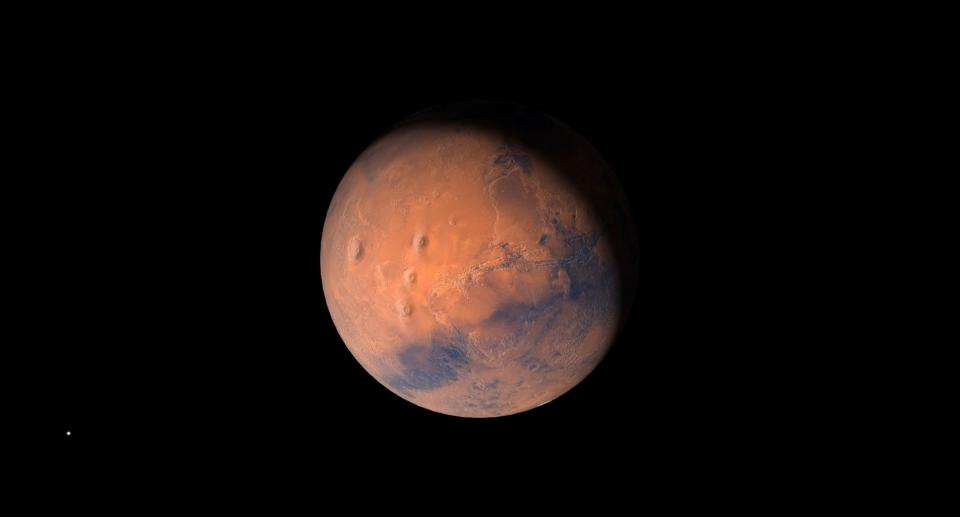When you buy through links on our articles, Future and its syndication partners may earn a commission.


Scientists are turning to machine learning to help with off-world sample analysis.
“This machine learning algorithm can help us by quickly filtering the data and pointing out which data are likely to be the most interesting or important for us to examine,” said Xiang “Shawn” Li, a mass spectrometry scientist in the Planetary Environments lab at NASA Goddard.
The new tech will first be applied to data collected by the Mars Organic Molecule Analyzer (MOMA), a cutting edge instrument that squeezes a “lab full of chemistry equipment into a package the size of a toaster.
MOMA will be sent to the Red Planet aboard the Rosalind Franklin Rover as part of the upcoming ExoMars mission, led by the European Space Agency (ESA). The rover, set to launch no earlier than 2028, will sample the surface of Mars in a bid to determine whether life ever existed there.
Related: Possible signs of Mars life: Astrobiologist explains Perseverance rover’s exciting find
The rover will be able to drill down an impressive 6.6 feet (2 meters) into the surface of Mars; previous rovers have only reached about 2.8 inches (7 centimeters) below the surface.
“Organic materials on Mars’ surface are more likely to be destroyed by exposure to the radiation at the surface and cosmic rays that penetrate into the subsurface,” said Li, “but two meters of depth should be enough to shield most organic matter. MOMA therefore has the potential to detect preserved ancient organics, which would be an important step in looking for past life.”
To do this, MOMA will be seeking out organic compounds — those that contain one or more atoms of carbon covalently linked to atoms of other elements, most commonly hydrogen, oxygen, or nitrogen — that may be found in drilled samples and could have originated from living matter.
To seek these molecules out, MOMA contains the most sophisticated mass spectrometer ever sent beyond Earth. Mass spectrometers are commonplace in laboratories on Earth, offering a fundamental way for scientists to identify molecules based on molecular weight. While there are more sophisticated and accurate techniques that scientists use to determine a molecule’s structure, MOMA’s mass spec instrument is perfectly suited to sort through samples of complex mixtures.
Like its predecessor, SAM, sent on the Curiosity rover, MOMA can prep samples collected by the rover, vaporizing materials in a high temperature oven before sending volatile molecules through a gas chromatograph that separates and analyzes the chemical components of the mixture. Separation occurs because the samples interact with two phases within the chromatograph’s column: a mobile gaseous phase and a stationary solid or liquid phase.
While being carried through the instrument in the gaseous phase, depending on their structure, elements, and general chemistry, different molecules in a sample mixture will interact differently with the column’s stationary phase — some will linger, forming temporary, weak bonds while others will just blast on through. This causes them to travel through the column at different speeds, thus separating out the mixture and then identifying individual components based on their masses and how they ionize.
What’s exciting about MOMA is that it contains a complementary mode of operation known as “laser desorption mass spectrometry.” Here, pulsed ultraviolet light is used to release and ionize organic molecules from the surface of a sample.
The duration of each laser pulse is incredibly short, less than two nanoseconds to be precise (where one nanosecond is one billionth of a second). This ultrafast pulse ensures that the process happens very quickly, allowing the preservation of weak chemical bonds and enhancing the precision of molecular identification.
While the instrumentation is impressive on its own, however, scientists are now training machine learning models to help them sort through the data that MOMA will be sending home. This is being done using laboratory data collected over the course of more than a decade.
“The more we do to optimize the data analysis, the more information and time scientists will have to interpret the data,” said Victoria Da Poian, a data scientist at NASA Goddard who co-leads development of the machine learning algorithm. “This way, we can react quickly to results and plan next steps as if we are there with the rover, much faster than we previously would have.”
Related Stories:
— Mars Express orbiter takes a deep dive into ancient Red Planet lake (images)
— ‘An oasis in the desert’: NASA’s Curiosity rover finds pure sulfur in Martian rocks
— Little Mars ‘snowman’ spotted by NASA’s Perseverance rover (photo)
The scientists train the machine learning algorithm by feeding it examples of samples that MOMA may find on Mars, identifying what they are so the algorithm can then identify them in real samples on its own, freeing up the team’s time.
“The long-term dream is a highly autonomous mission,” said Da Poian. “For now, MOMA’s machine learning algorithm is a tool to help scientists on Earth more easily study these crucial data.”
Li and Da Poian see potential for their algorithm to assist in future exploration beyond just Mars, including Saturn’s moons Titan and Enceladus, and Jupiter’s moon Europa.
